From the upcoming book All Over the Map: True Heroes of Texas Music by Michael Corcoran
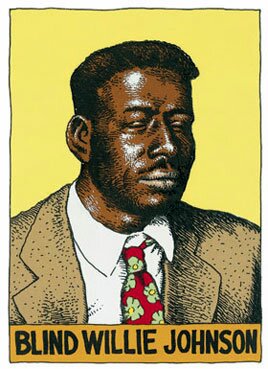
Blind Willie Johnson by Robert Crumb.
When Jack White of the White Stripes announced, “It’s good to be in Texas, the home of Blind Willie Johnson,” at Stubb’s in June 2003, you can be sure that few on hand had ever heard of the gospel blues singer/guitarist from Marlin who pioneered a ferocity that still lives in modern rock. We have become used to being saluted as the home of Willie Nelson, Buddy Holly and others. But Blind Willie Johnson? No doubt some in the sold out crowd thought it was a dick joke.
The first songs Blind Willie recorded, on a single December day in Dallas in 1927, are more familiar. “Nobody’s Fault But Mine” was covered by Led Zeppelin, Eric Clapton did “Motherless Children,” Bob Dylan turned Johnson’s “Jesus Make Up My Dying Bed” into “In My Time of Dying” on his 1962 debut LP and “If I Had My Way I’d Tear the Building Down” has been appropriated by everyone from the Grateful Dead to the Staple Singers.
Johnson’s haunting masterpiece “Dark Was the Night (Cold Was the Ground),” also recorded Dec. 3, 1927, was chosen by musicologist Alan Lomax for an album placed aboard the Voyager 1 in 1977 on its journey to the ends of the universe. Should aliens happen upon the spacecraft and, with the record player provided, listen to that eerie, moaning, steel-sliding memorial to the Crucifixion, they will know almost as much about the mysterious Blind Willie Johnson as we do.
Beyond five recording dates from 1927-1930 that yielded 30 tracks, the rough-voiced singer remains a biographical question mark. Only one picture of him, seated at a piano holding a guitar with a tin cup on its neck, has ever been found. A search on the Internet or a browse of libraries and bookstores reveals the slightest information on this musical pioneer, and, until recently, almost all of it was wrong.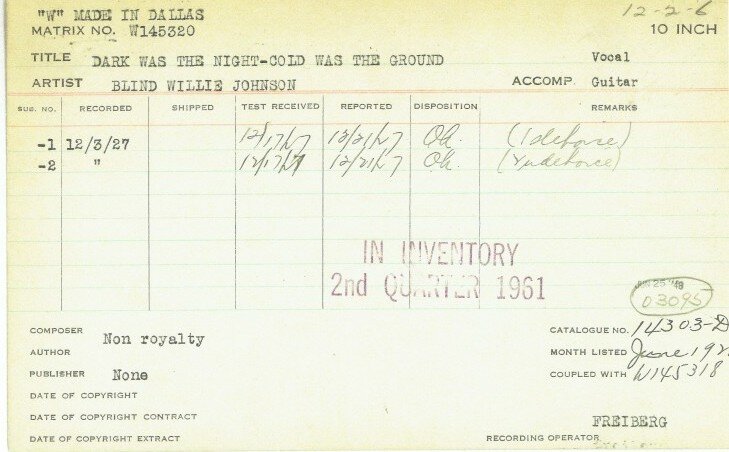
Months on the trail of the man whose music rang with an intensity previously unrecorded, turned up a living daughter and a death certificate – and little else. Finding witnesses who knew Johnson is about as easy as interviewing folks who lived through World War I. Many are dead or too old to remember.
Or, like Sam Faye Kelly, the only child of Blind Willie to come forward, they were too young to realize what was going on six, seven decades ago. “I remember him singing here in the kitchen and reciting from the Bible,” said Kelly, who was 72 and sickly when I interviewed her in 2003. (She passed away in 2005). Kelly, whose mother Willie B. Harris sang backup on Blind Willie’s later records, was back in Marlin, living in the house at 817 Hunter St. where she was most likely conceived.
The death certificate I found corrected some previously accepted misinformation (Blind Willie was born in 1897 near Brenham, not 1902 in Marlin, and died in 1945, not 1949, in Beaumont), but the document doesn’t tell you how he lived from 1930, when his recording career ended, until his death. It doesn’t tell you how many times he was married and how many kids he fathered. In fact, we’re not even sure if everything on the death certificate is true.
The informant was his third wife (that we know of) Angeline Johnson, who provided most of the accepted details about Johnson in a 1955 interview with music historian Samuel Charters. She told him that Willie was blinded when a stepmother threw lye in his face at age 7 to avenge a beating from his father. But she also told the story of Blind Willie being turned away from the hospital because he was black and blind (highly unusual, even in racist times) after contracting pneumonia from sleeping on a wet mattress after a fire. The official cause of death was malarial fever, with syphilis and blindness as contributing factors. Sometimes you just don’t know who to believe. So you start looking at documents, a nearly fruitless task when the subject is named Johnson.
Unquestioned is the opinion that the singing saint is one of the most influential guitarists in music history. “Anybody who’s ever played the bottleneck guitar with some degree of accomplishment is quoting Blind Willie to this day,” said Austin slide guitarist Steve James.
An instinctive virtuoso, Johnson made his guitar moan, slur and sing, often finishing lyrics for him, and throughout the years, Clapton, Jimmy Page, Ry Cooder and many more have expressed a debt to the sightless visionary. And yet, the 1993 double-disc Complete Blind Willie Johnson sold only about 25,000 copies on Sony/Legacy.
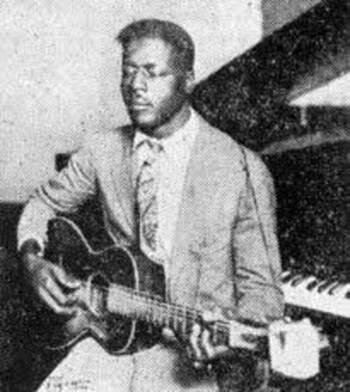
The only known photograph
The 1930s Mississippi Delta blues man Robert Johnson grew into a full-blown rock icon in part because of the mysteries of his life and death, but Willie Johnson has not benefitted from his enigmatic existence. Even though his playing, always on a Stella guitar, inspired a host of Delta blues men, from Johnson and Son House to Muddy Waters, Blind Willie refused to sing the blues, that style of pre-war music preferred by collectors and historians. He sang only religious songs, at least under his own name, which explains a big part of his relative obscurity. His gruff evangelical bellow and otherworldly guitar were designed to draw in milling, mulling masses on street corners, not to charm casual roots rock fans decades later.
So forceful were his vocals that, legend has it, he was once arrested in New Orleans on a trumped-up charge of trying to incite a riot when he sang “If I Had My Way I’d Tear The Building Down” with apocalyptic fury. How was the blind singer to know he was in front of a federal building? Johnson sometimes used two voices- normal and falsetto bass- on one song, as on “Let Your Light Shine On Me,” a device Dylan copied on his 1970 cover of Paul Simon’s “The Boxer.” Blind Willie McTell paid homage to his old friend Johnson’s voice when he cut “Motherless Children” for Atlantic in 1949, trying to also match the distinctive atmosphere of the other Blind Willie’s recording.
The legend of Blind Willie Johnson is growing slowly, but convincingly, like that moan on “Dark Was the Night.”
When word got out late 2002- to the 200 or so people who care- that Blind Willie had a daughter, there was a collective gasp of hope that new information would surface.
Maybe there was a box with pictures, letters or gospel programs that would fill in the huge gaps. Maybe Willie B. had told her daughter details about her father, like how he learned to play such nasty bottleneck. Would we finally know how much of an influence, if any, was an older preacher from Hearne with a deep, booming voice named Madkin Butler? Never recorded, Butler’s name came up in the liner notes Charters wrote for a 1965 compilation of BWJ recordings, but Butler.
The discovery of an heir also stirred the interest of musical estate manager Steve LaVere of Mississippi’s Delta Haze company, who visited Kelly in November 2002. In his role managing the estate of Robert Johnson, LaVere has aggressively collected back royalties from Columbia Records and such performers as the Rolling Stones and Led Zeppelin.
“It’s all about getting the pennies to roll in your direction – we’re talking about eight cents a record (in songwriter royalties),” LaVere said. “Eventually, the pennies turn into dollars.” LaVere’s cut is 50%, which seems like a lot, but he’s raised an estimated $20 million in royalties for Robert Johnson’s music, and half of $20 mil is better than all of nothing.
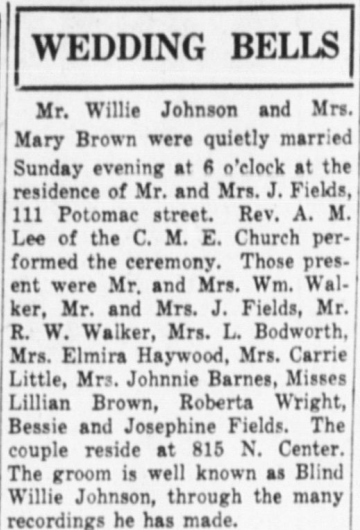
Blind Willie’s 1932 wedding announcement in the San Antonio Register
But when LaVere left Marlin to return to his offices in Greenwood, Miss., he didn’t have a signed contract that would give him the right to represent the estate of Blind Willie Johnson. “I was a little miffed,” he said in 2003. “I thought we had laid out the groundwork on the phone and would be able to sign a deal, but some people just don’t know what they have, what it’s worth, and they’d rather do nothing than feel like they might get cheated.”
Kelly said she just didn’t want to rush into anything. “You know, old people don’t like to sign stuff right away,” she said as she maneuvered her wheelchair through the cramped quarters of 817 Hunter St., a four-room box with a sagging roof and walls warped by the heat. Kelly said that she never received a penny from her father’s music.
But first she had to fly the flag, said lawyer William Krasilovsky, who wrote This Business of Music, an industry bible. “You say, ‘Here we are. We represent the heirs of Blind Willie Johnson.'” Until an estate is established, there’s no place to send royalties that may be due.
After Kelly passed away in 2005, her daughter in Seattle, Delois Ford, took up the task of setting up an estate. But just how much money might she be due?
First off, forget about lucrative songwriting royalties. Almost all of Johnson’s material was derived from such public domain sources as religious hymns and old “Negro spirituals.” But Krasilovsky said the Blind Willie estate could earn money by copyrighting his arrangements. “Does the work have distinctive fingerprints of originality that qualify for a new derivative copyright of public domain material?” he asked, reading from a copyright law book.
“Distinctive fingerprints” fits Blind Willie’s truly original style like the steel cylinder he used to slide over his pinky. ASCAP and BMI, organizations that collect songwriting royalties for artists and publishers, pay about half as much for copyrighted arrangements as they do for original compositions.
Sony/Columbia claims that Blind Willie Johnson’s recordings were made under the “work for hire” agreement prevalent at the time, and so they own the rights to the recordings. The label cards for Johnson’s sessions for Columbia in Dallas, New Orleans and Atlanta are all stamped “non-royalty,” so it’s doubtful he ever received any money from Columbia. Sony’s ownership of this sacred music made music historian Mack McCormick bristle back in ‘03. “They can’t produce a contract, they can’t produce the masters,” he said. “Look at the source material for the Blind Willie set. They had to borrow 78s from collectors. Sony claims they own the music and they don’t even have copies of the fuckin’ records!”
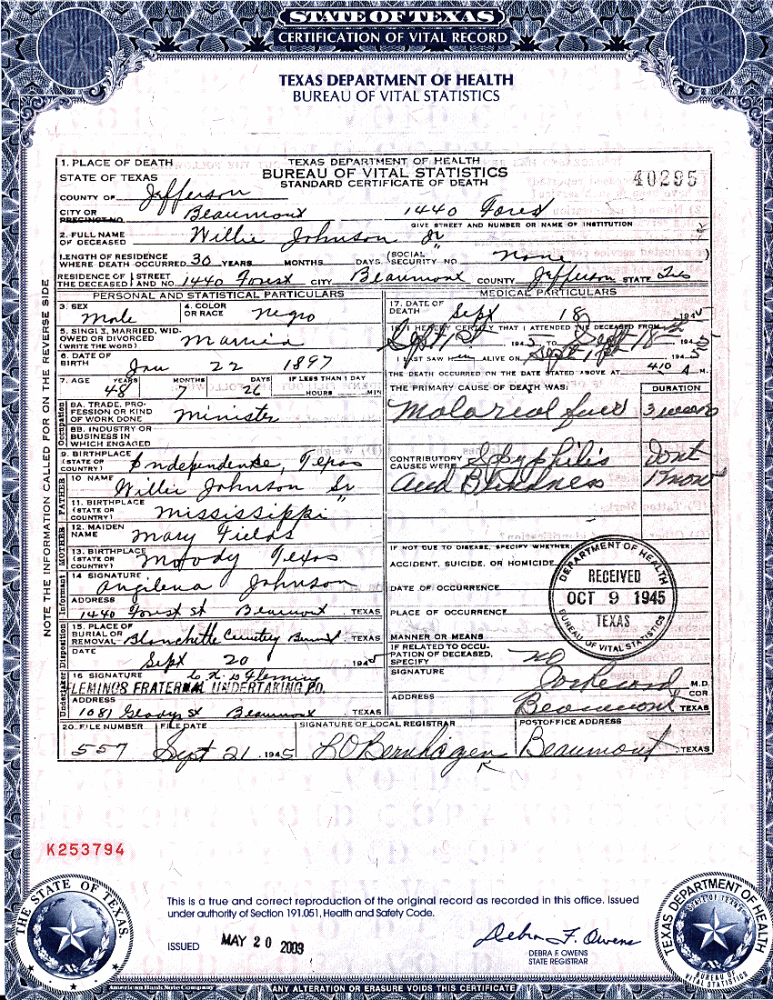
BWJ’s death certificate.
Sam Faye Kelly had only one bit of proof that her father was Blind Willie Johnson, a birth certificate which says that she was born in Marlin on June 23, 1931, to Willie Johnson, occupation listed as “musician,” and a mother whose maiden name was Willie B. Hays.
But Blind Willie was married again the next year, to a Mary Brown, with the event recorded in the Dec. 2, 1932 San Antonio Register. The small wedding took place in the home of Mr. and Mrs. J. Fields, who were probably Blind Willie’s uncle and wife. If the black female Mary Fields (b. 1864) of McLennan County, found in the 1880 U.S. Census, is the same Mary Fields of McLennan County listed as Blind Willie’s mother in his death certificate, she had a brother named John. It’s not known if any children came from the union with Mary Brown or how long Blind Willie lived in San Antonio. He might’ve still been living there on November 23, 1936 when Robert Johnson made his first recordings (including “I Believe I’ll Dust My Broom” and “Crossroad Blues”) at the Gunter Hotel.
But by 1937 he was living in Corpus Christi and married to a woman named Annie (Angelina perhaps?), according to the city directory. Being blind and out on the road, it’s possible that Blind Willie, a handsome man of great talent, had a woman in several cities, to pick him up from the train station and give him something to eat. Back then, if you were poor and black, you jumped the broom to get married. No fees, no paperwork involved.
But although research nerds may find these biographical morsels intriguing, nothing really matters like the music. It’s so supercharged with self-expression that the truth is right there for all to hear. And the soul of Blind Willie connected with listeners right out of the box.
Johnson’s first 78 rpm – “I Know His Blood Can Make Me Whole” b/w “Jesus Make Up My Dying Bed” – sold 15,400 copies at 75 cents each in 1928. His best-selling record was third single “If I Had My Way I’d Tear the Building Down” b/w “Mother’s Children Have a Hard Time” (titled “Motherless Children” by Clapton) – which moved nearly 17,000 discs, even more than Bessie Smith’s recordings of the day. By 1930, however, Blind Willie’s recording career was history, though Columbia did reissue some of his records in 1935, very rare during the Depression.
He kept singing and playing through the ‘30s, with his friend McTell tracing a touring route for the pair “from Mobile to Maine” to interviewer John A. Lomax. “People recalled hearing him at times over KTEM in Temple and on a Sunday-morning church service broadcast by KPLC in Lake Charles,” said McCormick, whose obsessive research into Robert Johnson is legendary. “He left memories in Corpus Christi during WWII when there was a fear about Nazi submarines prowling the Gulf of Mexico. Someone must have told him submarines often listened to radio stations to triangulate their position. He went on the air with new verses to one of his songs, probably ‘God Moves on the Water’ about the Titanic, offering grace to his audience, then followed with a dire warning to the crew of any listening U-boat with ‘Can’t Nobody Hide from God.’ ”
Blind Willie’s music was revealed to a new generation of country blues enthusiasts (including Bob Dylan) with the 1952 release of the Harry Smith anthology American Folk Music, which included Johnson’s “John the Revelator,” recorded in Atlanta in 1929. The Blind Willie Johnson album came out on Folkways in 1957, with a key detail wrong. Angeline Johnson was credited with the backing vocals performed by first wife, Willie B. Harris.
This error was uncorrected until the mid-’70s, when Dallas artist and music collector Dan Williams drove down to Marlin to see if he could find anyone who knew Blind Willie. “I approached a group of elderly black people near the town square and one of them said he was related to Blind Willie’s ex-wife, the one who sang on his records, and I thought I was going to meet Angeline Johnson,” Williams recalled in 2003. “Nobody knew anything about a Willie B. Harris.”
After hearing Harris sing along to the Blind Willie records and talk about details of the recording sessions that only those present would know, Williams ascertained that she was, indeed, the background singer.
“She talked about meeting Blind Willie McTell at the last session in Atlanta (April 20, 1930) and I did some research and found out that, sure enough, McTell recorded at the same studio the same day.”
Charters made the correction, crediting Harris, in his notes to the 1993 boxed set, but repeated Angeline Johnson’s contention that she married Blind Willie in Dallas in 1927. There is no record of such a marriage in Dallas County, or in the county clerks offices of Falls, McLennan, Bell, Milam, Jefferson or Robertson counties. But then, neither is there evidence, besides Kelly’s birth certificate listing her as legitimate, that Blind Willie and Willie B. were ever married.
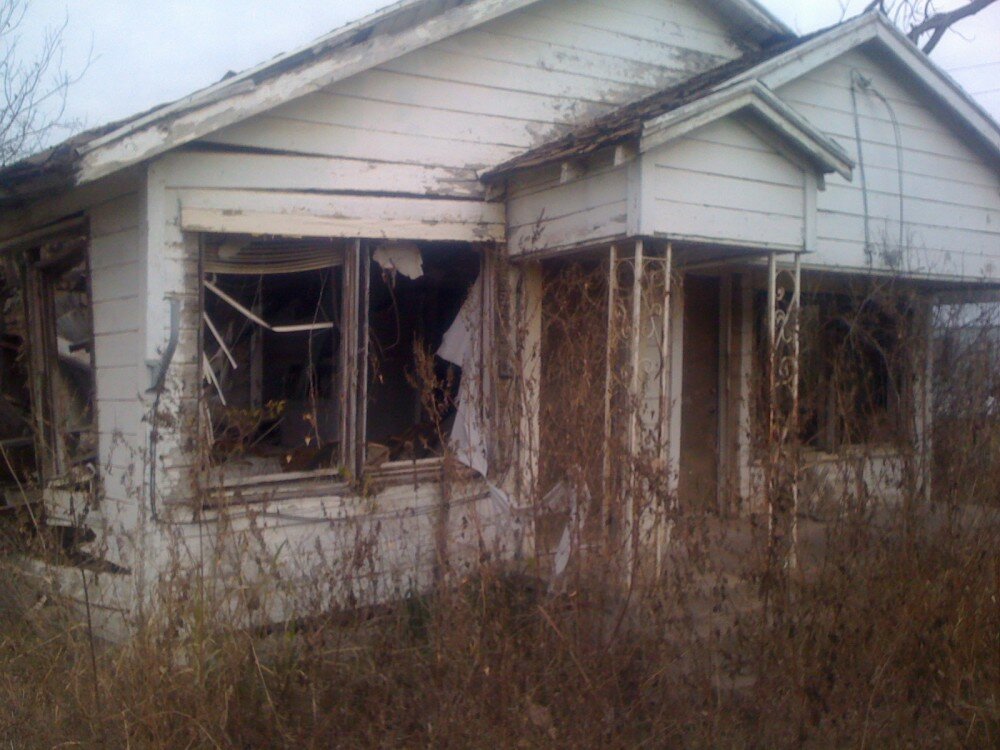
The house at 817 Hunter St. in Marlin in 2011. It was torn down two years later.
Researching history about long dead gospel and blues singers is fueled by random payoffs, much like slot machines and singles bars. You run your fingers down the pages of big, dusty books for hours and then you find a bit of information, a bit of new evidence, and it all becomes worth it.
But dozens of hours in search of details on the life of Blind Willie Johnson resulted in almost zero positive reinforcements. A five-hour drive to Beaumont yielded the slightest new info; a city directory shows that in 1944, a Rev. W.J. Johnson, undoubtedly Blind Willie, operated the House of Prayer at 1440 Forest St. That’s the address listed on Blind Willie’s death certificate as his last residence. The directory puts Willie and Angeline in the St. Charles Hotel, a posh name for a rooming house, at 555 Forsythe St. in 1941.
Besides the entry on the death certificate, there is no evidence that Blind Willie Johnson is buried in Beaumont’s “colored” Blanchette Cemetery, a seemingly untended field littered with broken tombstones and overrun with weeds. If Johnson had a headstone, it’s gone now. When the cemetery floods, a man who lives across the street said, sometimes wooden coffins can be seen floating away amongst the debris. There is no peaceful rest, no solitude for the ages, for the migrant musician.
His music, meanwhile, continues its journey to the galaxy’s back yard. In 2013, Voyager 1 left the solar system and is now more than 12 billion miles away. Ry Cooder, who based his desolate soundtrack to “Paris, Texas” on “Dark Was the Night (Cold Was the Ground),” described it as “the most soulful, transcendent piece in all American music.” On that Voyager 1 disc is hard evidence that we are a spiritual people, that we hurt and we heal, that we do indeed have souls that live long after we’re buried.